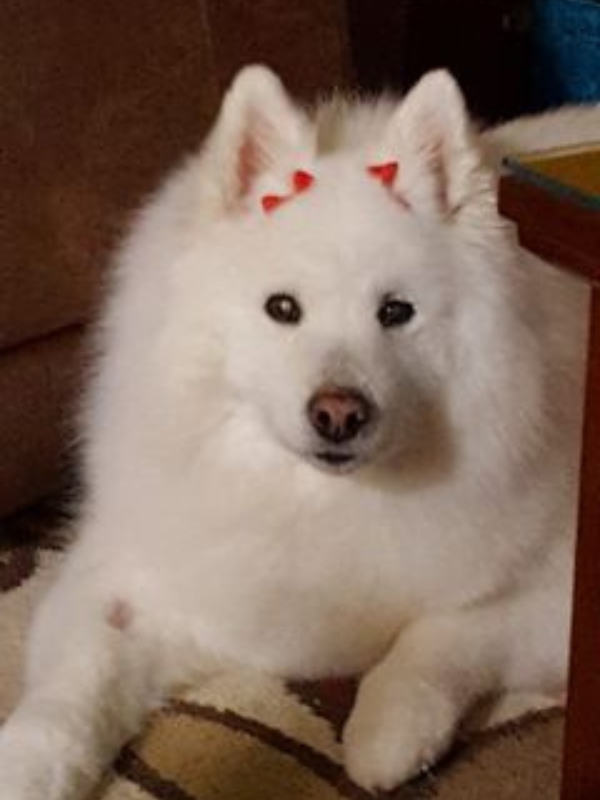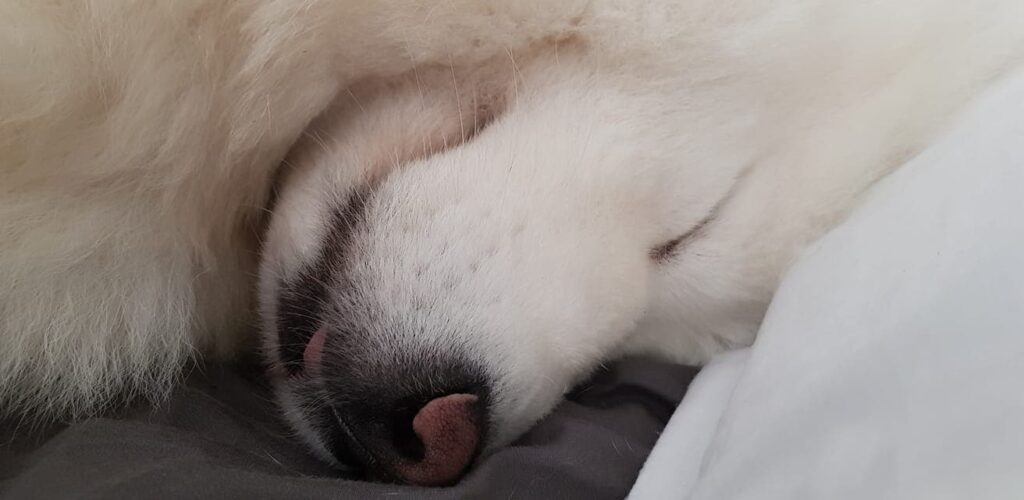If you are familiar with the Samoyed breed, you already know how adorable they are! Their white fluffy fur, thick ears, and almond-shaped eyes are some of the characteristics that make this breed so unique.
This breed is commonly known for having different nose pigmentations, usually in the form of pink spots/splotches, or even overall pinkness of the nose.
Some owners often worry if their Samoyed is born with a pink nose, or if they begin developing one over time; thankfully, this usually is nothing to worry about!
There are several reasons why a Samoyed’s nose can begin turning pink. Some reasons include their genetics, weather/season change, and their overall health.
In this article, we will talk about several reasons why a Samoyed can be born with or develop a pink or discolored nose over time.
Disclaimer: This post may contain affiliate links. We only recommend high-quality products that are used and recommended by real owners. If you use these links to buy something we earn a small commission.
If you are interested to learn the reasons for this breed’s unique nose colors, keep reading to find out!



Reason #1: Genetics
A lot of times strange things begin happening to our dogs and we can’t seem to figure out why. Oftentimes, these things begin happening to our dogs because of their genetics.
Genetics is one of the reasons why Samoyed’s will oftentimes develop unique pigmentation i.e., spots or patches of color, or even completely pink noses!
If your Samoyed’s parents have pink noses or splotchy pigmentation on their noses, this usually means there is a high chance your dog will develop this too if they haven’t already!
If you are curious whether or not your Samoyed may develop a pink nose, try looking at their parents and seeing if they have different nose colors.
Your Samoyed may also be born with a pink nose. Typically, their noses will become darker over time, but in some cases, they will change colors back and forth consistently throughout their lives.
NOTE: Some Samoyed owners said that their puppy was born with a pink nose, and it never went away.
There is nothing to worry about if your dog’s nose isn’t changing pigments over time; the best thing to do is check with your vet to make sure there aren’t any illnesses or diseases causing your dog’s pigmentation changes, or lack of change!

Reason #2: Pigmentation
One of the most common reasons Samoyeds are born with or develop pink pigmentation on their noses is because of the breakdown of an enzyme called “tyrosinase” (A.K.A – the enzyme that makes melanin — which gives the skin its different pigments!)
The Samoyed breed is more likely to have a pink nose because their fur is white. Because they are genetically lacking melanin already (which causes their white fur) it is no surprise that their noses will oftentimes lack pigment too!
There are also other skin pigmentation issues that can cause a Samoyed to develop pink in their nose, such as Vitiligo.
Vitiligo is a disease that causes the skin to lose its color, causing it to look patchy. This is not only limited to dogs; humans can also develop this skin disease.
Dogs that have this skin condition must be careful in the sun because they are more likely to become sunburnt.
Thankfully there are many great dog sunscreens available, here is one of the most popular: Epi-Pet K-9 Care Sunscreen
TIP: When applying a spray sunscreen to your dog’s nose, try spraying it into your hand first and then applying it, this can help avoid getting it in their eyes!

Reason #3: Weather/Season Change
Because of the enzyme mentioned above, the pigmentation on a Samoyed’s nose can change as the seasons’ change. There is less sun in the winter, which means the dog’s skin is getting less melanin.
A Samoyed’s pink nose is oftentimes called a “Snow Nose.” This name comes from the idea that their noses turn a lighter color such as pink or light brown when the weather gets colder; however, the snow is not actually causing their noses to change color!
Temperature plays a huge role in the pigment changes of a Samoyed’s nose. The enzymes that make a dog’s skin pigmentation are very sensitive to cold and hot!
You may notice that your dog’s nose turns pinker as the weather gets colder, and then turns black again once the sun and warm weather reappear.
NOTE: Sometimes a change in color/pigment can make a dog’s nose drier or more wet, this can be affected by the colder weather too. Thankfully, there are many products available that can help your dog with its overly dry or wet nose!
Even a dog who isn’t experiencing changes in seasons/weather can develop pigmentation spots on their noses, this is usually because of sun exposure, skin conditions, genetics, or illness.
The best thing a Samoyed owner can do if their dog’s nose begins changing colors is to visit the vet to determine why exactly they’re losing or gaining pigment in their skin.

Reason #4: Health Issues
Like most other dog breeds, Samoyeds are more susceptible to certain health problems compared to other breeds.
Some of the most common issues for Samoyeds include eye disease/blindness, diabetes, hip dysplasia, skin issues, etc.
There are, however, health problems that are specifically linked to pigmentation changes on the nose.
Here are some of the most common health problems that can cause these pigmentation changes:
- Autoimmune Disorders
- Injury
- Thyroid
- Immune-related skin disorders
- Too much sun exposure
- Skin Cancers
- Old age
As mentioned above, the lack of melanin in a Samoyed’s nose makes them more likely to develop sunburn and, in turn, skin cancers.
There are certain skin cancers that are more likely to develop in dogs. Some of the most common include melanoma, mast cell tumors, squamous cells, and fibrosarcoma.
A lot of times Samoyeds that develop skin issues already have something going on with their autoimmune systems which typically leads to skin disease/disorders related to the immune system.
Two of the most common autoimmune skin diseases/disorders include “pemphigus” and “discoid lupus,” both of which will show symptoms of sores around the nose and the appearance of pink splotches/discoloration of pigments.
Thankfully, there are many medications and treatment options available that can help Samoyeds who develop skin issues caused by their immune systems.

Read these articles next: (All About Samoyeds!)
While we strive to give the most accurate and helpful information about your pet’s health that we can, this article is meant to be informational only and not medical advice. Never disregard, avoid or delay in obtaining medical advice from your veterinarian or other qualified veterinary health care provider regardless of what you have read on this site or elsewhere.



